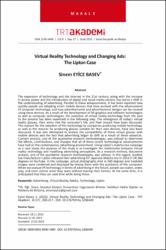| dc.contributor.author | Eyice Basev, Sinem | |
| dc.date.accessioned | 2023-10-06T17:55:10Z | |
| dc.date.available | 2023-10-06T17:55:10Z | |
| dc.date.issued | 2023 | en_US |
| dc.identifier.issn | 2149-9446 | |
| dc.identifier.uri | https://hdl.handle.net/11363/5803 | |
| dc.description.abstract | The expansion of technology and the Internet in the 21st century, along with the increase
in access power and the introduction of digital and social media sectors, has led to a shift in
the understanding of advertising. Parallel to these advancements, it has been explored how
quickly people are adopting smart mobile devices that have evolved with the advancement
of computer technology, and how advertisements and advertisement designs can be created
using these devices. As a result of the development of 3D graphics and software technologies
as well as computer technologies, the evolution of virtual reality technology from the past
to the present has been examined in the following step. The emergence of today's virtual
reality glasses, their entry into the consumer's life, and their impact have been discussed.
The reasons for the adoption of this technology by companies producing mobile technology,
as well as the reasons for producing glasses suitable for their own devices, have also been
discussed. It was also attempted to analyze the compatibility of these virtual glasses with
mobile devices and the fact that advertising began to shift as a result of these advances.
Content analysis, one of the qualitative research methodologies, was utilized to determine
the effects, contributions, and changes that all of these recent technological advancements
have had on the contemporary advertising environment. Using Lipton's matcha tea campaign
as a case study, the purpose of this study is to investigate the relationship between virtual
reality technology and modifying advertising perceptions. As a research method, document
analysis, one of the qualitative research methodologies, was utilized. In this regard, Scottish
tea manufacturer Lipton released their advertising for Japanese Matcha tea in 2016 in VR 360
degrees on YouTube. In the campaign, actual photographs shot in 360 degrees and modeled
images were combined and displayed by mixing them with the assistance of the computer.
When we analyze VR technology in terms of advertising in the future, people can watch, order,
play, and even control what they want without leaving their homes; At the same time, it is
anticipated that they can save time while doing these. | en_US |
| dc.description.abstract | 21. Yüzyıl içerisinde teknoloji ve internetin gelişimiyle birlikte, erişim gücünün artması, dijital
ve sosyal medya alanlarının ortaya çıkmasıyla reklamcılık anlayışının değişimine neden olmuştur. Bu gelişimlere paralel olarak bilgisayar teknolojilerinin de ilerlemesiyle, ortaya çıkan akıllı
mobil cihazların, insanlar tarafından tüketilerek hızlı benimsendiği, reklamların ve reklam tasarımlarının bu cihazlar üzerinden nasıl yapılabileceği tartışılmıştır. Daha sonraki süreçte bilgisayar teknolojilerinin yanı sıra, 3 boyutlu grafik ve yazılım teknolojilerinin de gelişiminin bir
sonucu olarak sanal gerçeklik teknolojisinin nasıl ortaya çıktığı ve gelişim gösterdiği geçmişten
bugüne araştırılmıştır. Günümüzde çıkan sanal gerçeklik gözlüklerinin ortaya çıkışı ve tüketicinin hayatına girmesi ve bıraktığı etki; mobil teknoloji üreten firmalar tarafından bu teknolojinin
benimsenmesi ve kendi cihazlarına uygun gözlükler üretmelerinin nedenleri aktarılmaya çalışılmıştır. Çıkan bu sanal gözlüklerin mobil ile uyumlu çalışması ve reklamcılığın bu gelişmelerden
etkilenerek, değişime uğramaya başlaması da incelenmeye çalışılmıştır. Son dönemde yaşanan
tüm bu teknolojik gelişmelerin günümüz reklam dünyasına ne gibi etki, katkı ve değişikliklere
sebep olduğu nitel araştırma yöntemlerinden biri olan içerik inceleme kullanılarak yapılmıştır.
Bu bağlamdan yola çıkılarak araştırmanın amacı, sanal gerçeklik teknolojisi ve değişen reklam
algısının Lipton matcha çayı reklamı örneği üzerinden incelenmesidir. Araştırma yöntemi olarak
nitel araştırma yöntemlerinden doküman incelemesi kullanılmıştır. Bu bağlamda İskoç çay markası Lipton, 2016 yılında Japonya’ya özgü Matcha çayı için yaptığı reklamı YouTube üzerinden
VR 360 derece olarak sunmuştur. Reklamda 360 derece çekilmiş gerçek görüntüler ve modellenmiş görseller kullanılıp, bilgisayar yardımıyla birleştirilerek sunulmuştur. Gelecekte reklamcılık açısından VR teknolojiyi değerlendirdiğimizde, insanların evlerinden çıkmadan istedikleri
şeyleri izleyebildikleri, sipariş edebildikleri, oynayabildikleri ve hatta kontrol edebildikleri; aynı
zamanda bunları yaparken zamandan tasarruf edebilecekleri düşünülmektedir. | en_US |
| dc.language.iso | eng | en_US |
| dc.publisher | TRT | en_US |
| dc.relation.isversionof | 10.37679/trta.1206349 | en_US |
| dc.rights | info:eu-repo/semantics/openAccess | en_US |
| dc.rights | Attribution-NonCommercial-NoDerivs 3.0 United States | * |
| dc.rights.uri | http://creativecommons.org/licenses/by-nc-nd/3.0/us/ | * |
| dc.subject | Advertising | en_US |
| dc.subject | Virtual Reality | en_US |
| dc.subject | Media | en_US |
| dc.subject | Technology | en_US |
| dc.subject | Lipton | en_US |
| dc.subject | Reklamcılık | en_US |
| dc.subject | Sanal Gerçeklik | en_US |
| dc.subject | Medya | en_US |
| dc.subject | Teknoloji | en_US |
| dc.subject | Lipton | en_US |
| dc.title | Virtual Reality Technology and Changing Ads: The Lipton Case | en_US |
| dc.title.alternative | Sanal Gerçeklik Teknolojisi ve Değişen Reklamlar: Lipton Örneği | en_US |
| dc.type | article | en_US |
| dc.relation.ispartof | TRT Akademi | en_US |
| dc.department | Uygulamalı Bilimler Fakültesi | en_US |
| dc.authorid | 0000-0001-8936-1985 | en_US |
| dc.identifier.volume | 8 | en_US |
| dc.identifier.issue | 17 | en_US |
| dc.identifier.startpage | 200 | en_US |
| dc.identifier.endpage | 217 | en_US |
| dc.relation.publicationcategory | Makale - Ulusal Hakemli Dergi - Kurum Öğretim Elemanı | en_US |
| dc.contributor.institutionauthor | Eyice Basev, Sinem | |



















